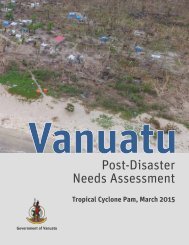Fiji
yqgk302EGjo
yqgk302EGjo
You also want an ePaper? Increase the reach of your titles
YUMPU automatically turns print PDFs into web optimized ePapers that Google loves.
FIJI Post-Disaster Needs Assessment<br />
This PDNA identifies a number of key needs to support recovery and reconstruction objectives. The identification and<br />
valuation of disaster effects has been used for estimating disaster impacts at the sector, macro and micro levels, and the<br />
results of the effects and impact analyses have provided inputs for the quantification of recovery and reconstruction needs.<br />
Workshop discussions with key stakeholders, and interviews with affected people and government officials, have also<br />
supported the process.<br />
Recovery and reconstruction needs for all disaster-affected sectors of social and economic activity have been estimated<br />
within this PDNA. Recovery and reconstruction needs refer to both the private and public sectors, as both have been<br />
affected by the disaster and, thus, have also been included. This does not imply that the government should finance<br />
recovery and reconstruction for all stakeholders. Rather, it allows the government to quantify and finance those needs<br />
within its purview, and facilitate private sector recovery, for example, through interactions with the banking sector to ensure<br />
that the required credit lines are available. This approach will support the full recovery of social and economic activity by all<br />
disaster-affected sectors, people and enterprises.<br />
No one agency or group will be able to achieve recovery alone. Collaboration is essential to connect those who have a<br />
role in recovery, including those in government, business, cultural and other non-governmental sectors. By establishing<br />
and maintaining constructive relationships, agencies will be able to undertake initiatives that are coordinated, timely and<br />
enduring. Recovery activities will also need to be implemented in various ways. For example, some agencies will coordinate<br />
with each other on new initiatives and others will reorient or adapt business as usual.<br />
5.1 Modalities for Recovery and<br />
Reconstruction<br />
A range of modalities for recovery and reconstruction exist, a combination of which may be comprised of:<br />
<br />
<br />
<br />
<br />
donations for recapitalization and reconstruction purposes;<br />
<br />
to credit-worthy private individuals and businesses for both working capital replenishment and reconstruction<br />
purposes; and<br />
<br />
until universal participation is eventually reached.<br />
The government will seek to facilitate private sector participation in recovery, given that damage and losses to the private<br />
sector are approximately three quarters of the total effects.<br />
5.2 Overview of Recovery and<br />
Reconstruction Needs<br />
The total damage and losses for TC Winston is approximately F$1.99 billion (excluding the environment). Total recovery<br />
and reconstruction costs are estimated at F$1.96 billion (US$0.9 billion). Of this amount, F$0.22 billion (US$0.1 billion) will<br />
focus on recovery needs, F$1.71 billion (US$0.8 billion) will focus on reconstruction and F$31 million (US$14 million) will<br />
focus on resilience activities.<br />
Recovery and reconstruction efforts will initially focus on the most affected sectors, while also ensuring that other affected<br />
sectors are supported.<br />
Table 76 presents the recovery, reconstruction and resilience needs by sector. The majority of the activities are required<br />
in the short to medium term, with the objective of restoring stability to livelihoods and services in the various sectors. The<br />
identification of priority and rehabilitation efforts will be implemented by the relevant government agencies and statutory<br />
bodies with assistance from development partners. The timeframes for these interventions (indicated in Annex 2) are<br />
purely indicative, as institutional arrangements, financial support and other factors will influence the timetables and length<br />
of involvement (please refer to the individual sector assessments within Chapter 3 of this PDNA for further details). Shortterm<br />
needs will be developed further in the DRF. Medium- and long-term needs will be developed further in the National<br />
Development Plan.<br />
Tropical Cyclone Winston, February 20, 2016<br />
119



